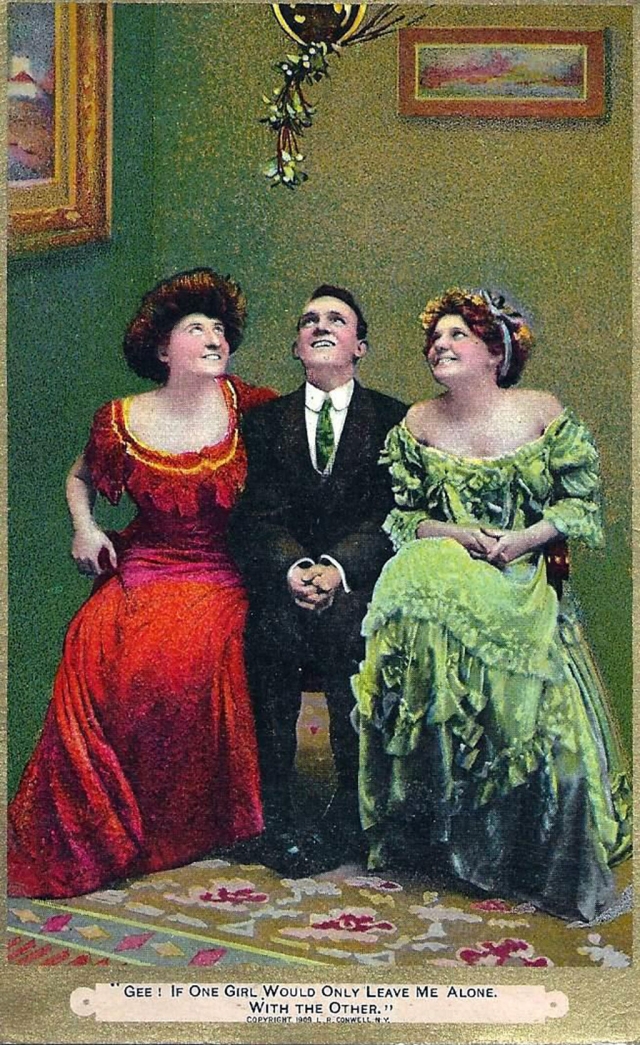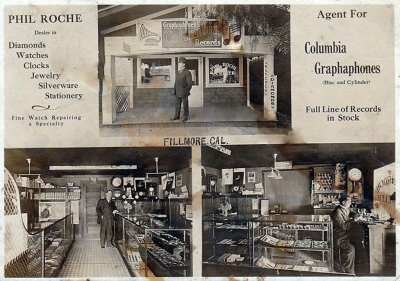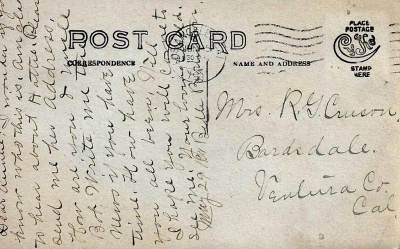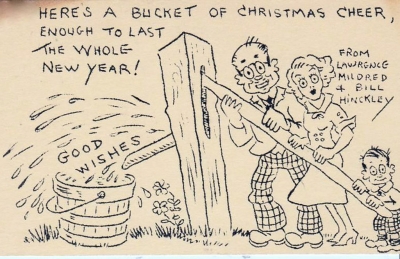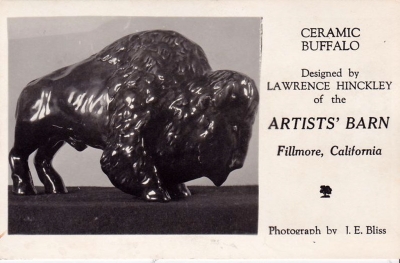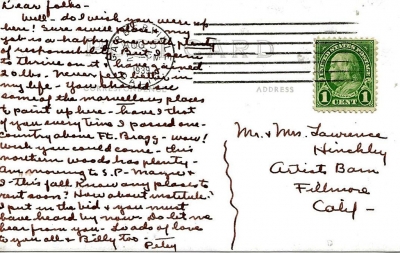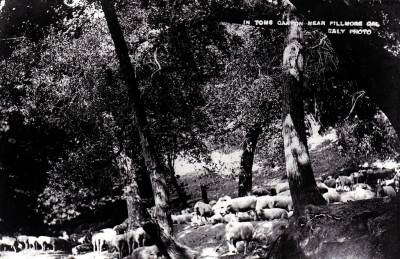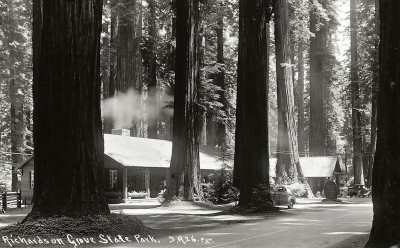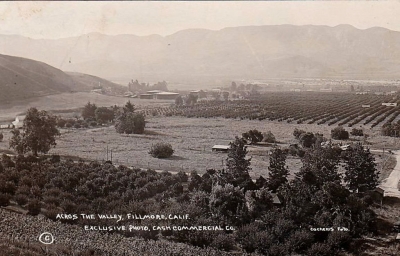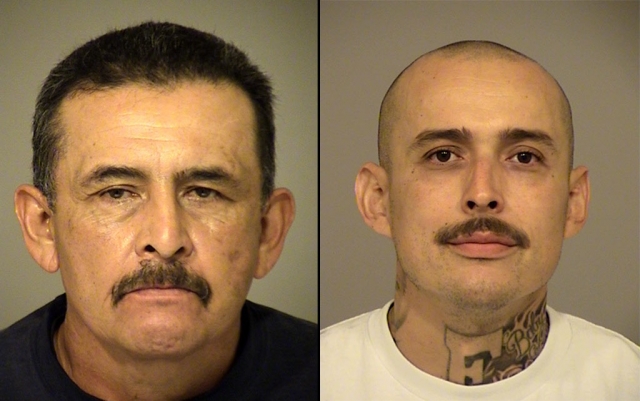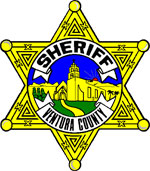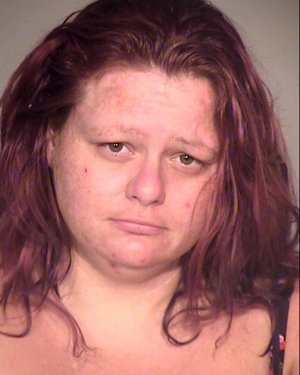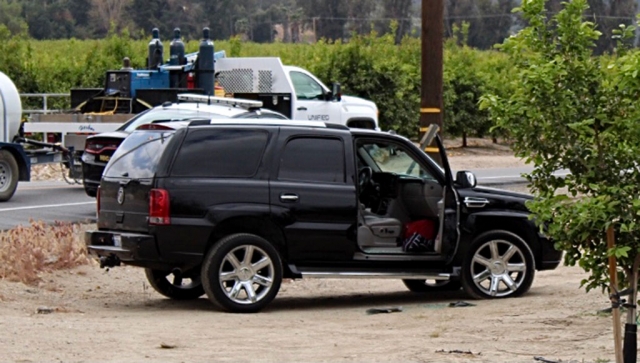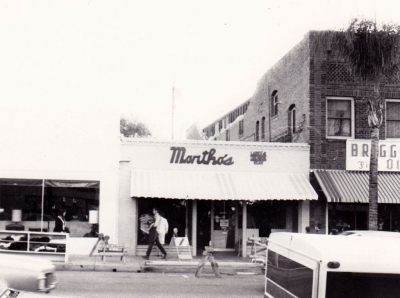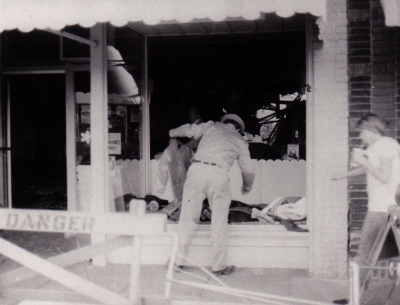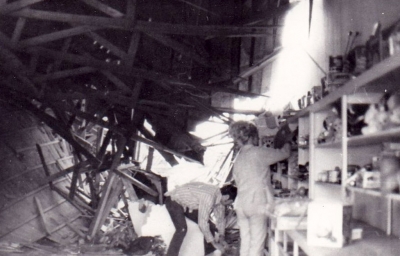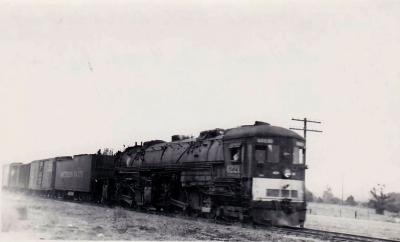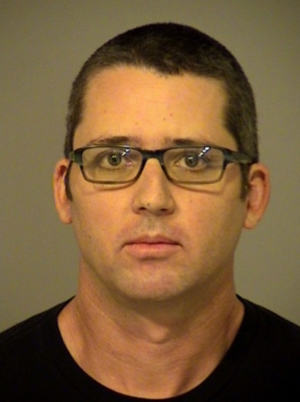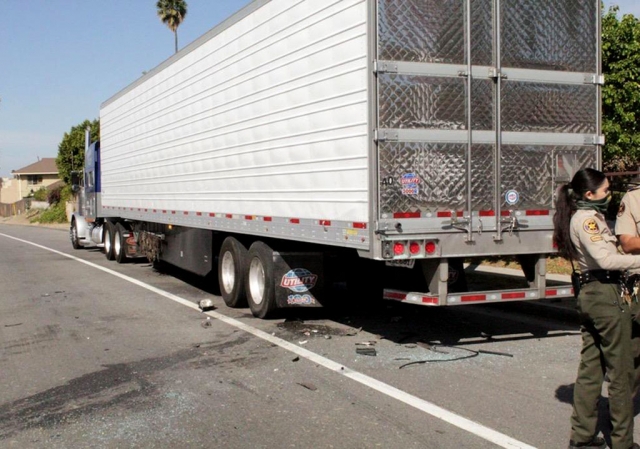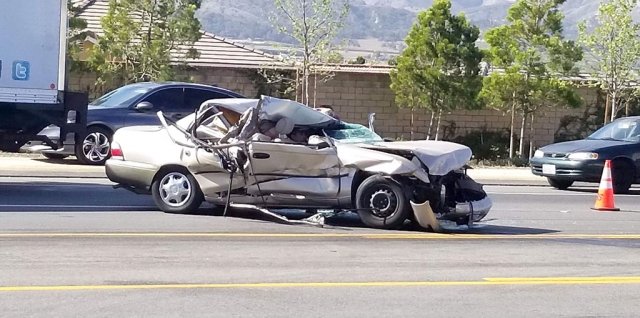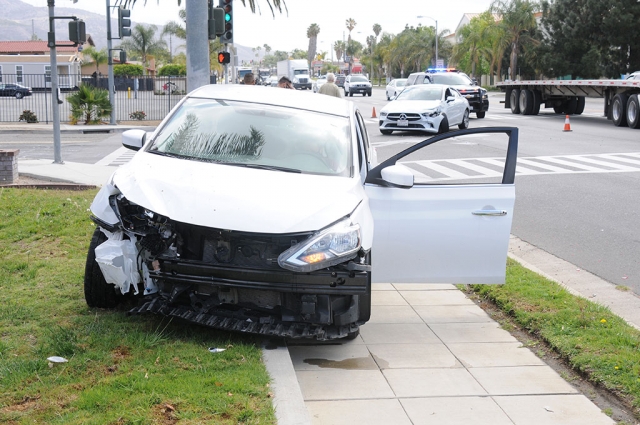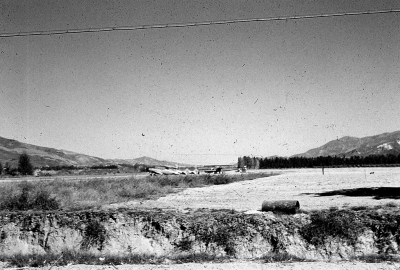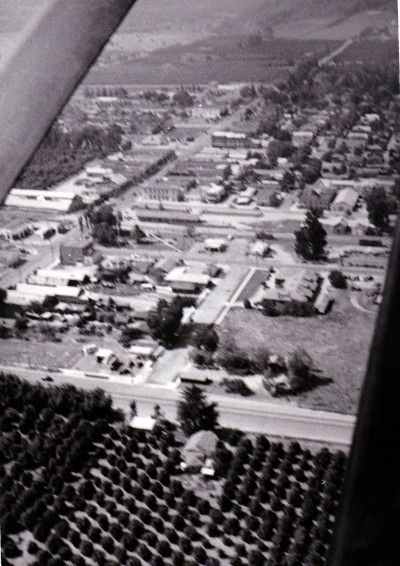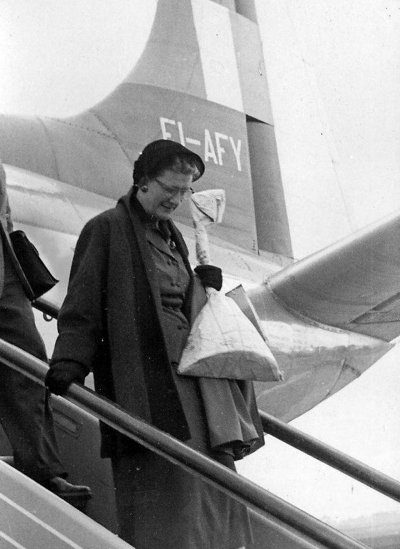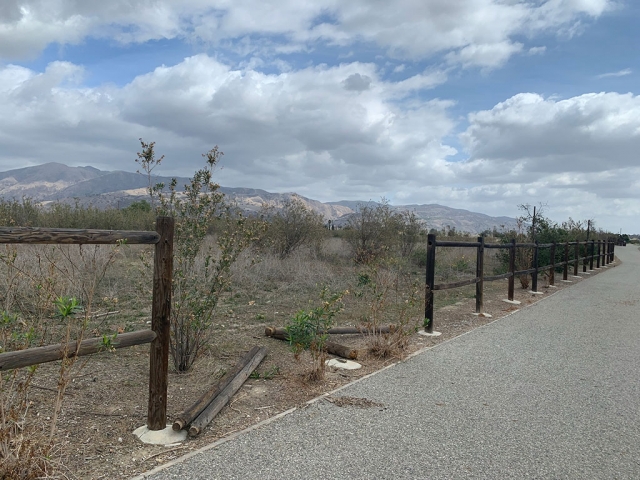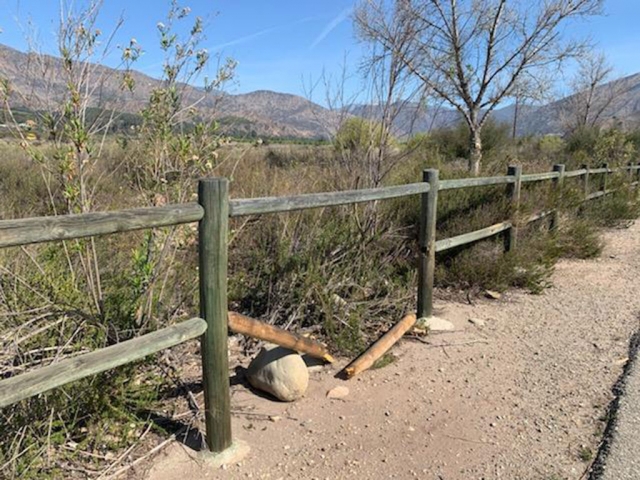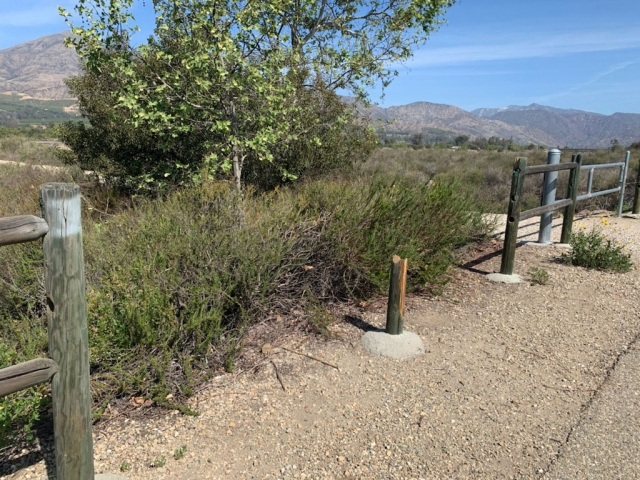|
By Anonymous — Wednesday, May 5th, 2021
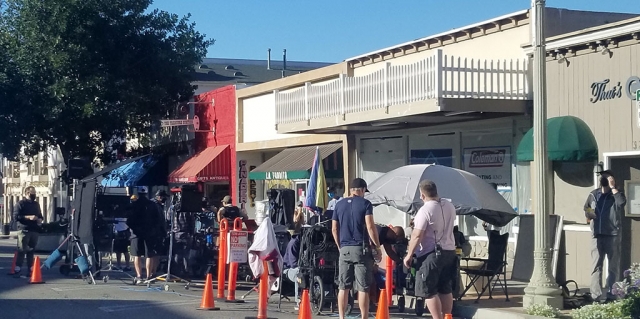 On Thursday morning, April 29th, next to the post office on Central Avenue, film crews were set up and blocking off part of the street to film a promo for a food network. Enlarge Photo |
|
By Anonymous — Wednesday, May 5th, 2021
![Who is this postcard to Susan Cruson - front [back of card below] suggested caption Mrs. R. G. Cruson, or Susan Crusan, was Kate Crusan Hinckley’s mother, grandmother to Lawrence Hinckley of the Artists’ Barn. Note the address was just, “Bardsdale, Ventura Co. Cal.”](/files/imagecache/400wide/files/fhm-postcards-05-04-21-3-Who-is-this._0001.jpg) Who is this postcard to Susan Cruson - front [back of card below] suggested caption Mrs. R. G. Cruson, or Susan Crusan, was Kate Crusan Hinckley’s mother, grandmother to Lawrence Hinckley of the Artists’ Barn. Note the address was just, “Bardsdale, Ventura Co. Cal.” Enlarge Photo 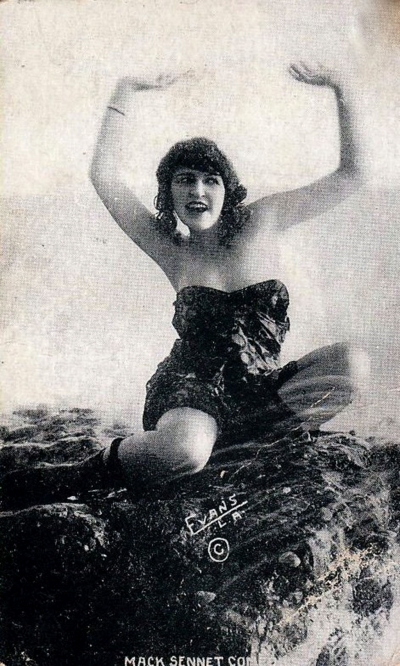 Mack Sennett Postcard - suggested caption: Beginning in 1915, Mack Sennett assembled a bevy of women known as the Sennett Bathing Beauties to appear in provocative bathing costumes in comedy short subjects, in promotional material, and in promotional events such as Venice Beach beauty contests. The Sennett Bathing Beauties continued to appear through 1928. Enlarge Photo Courtesy Fillmore Historical Museum The penny postcard was an effective, inexpensive way to let your friends and relatives know what was going on, even to let family know of the death of a loved one. When was the last time you received a postcard which wasn’t an advertisement or political appeal? When was the last time you sent one? If at all, it was probably before the pandemic since today postcards are usually sent by travelers to crow over the wonderful sites they are seeing. That wasn’t the case one hundred years ago or more. We have many interesting (yes, even some of the “French” postcard type) in our collection. Some commercially produced, but others were made from the person’s own photography. The first postcards were introduced in the 1860s. It was an easy, inexpensive way to send a message. They really took off in the 1890s when color printing became economical. The cards were embraced as greeting cards, business advertisements and “Greetings from….” cards for travelers. Businesses sometimes sent advertising cards such as the one in our collection for Roche Jewelry on Central Avenue. Photos show the interior and exterior of the shop with Phil Roche center stage. It also declares the business to be an agent for Columbia Graphaphones with a full line of records in stock. Mr. Roche may have embraced postcards for another reason – he was the local postmaster and housed the post office. Other businesses were more subtle. Union Oil of California produced a line of scenic postcards in the 1930s that were given away when gasoline was purchased. Fillmore’s counterpart was Cash Commercial Grocery. They issued a series of postcards showing the scenery of the Santa Clara Valley and the Sespe. It is not known for sure how these were distributed, but it was possibly a free card with the purchase of a specified number of groceries. Locals sent them around the country with messages for friends and families. (Hint for anyone wanting to collect local postcards, look for them elsewhere. They were made to be sent away). Even artists recognized the use of postcards to advance their careers and projects. Lawrence Hinckley created many cards, especially for his lines of ceramic items. The postcard advertising the ceramic buffalo featured a photograph by local dentist Jim Bliss, who was also a composer. Local photographers would also issue series of postcards. Ray Ealy was a local photographer who also worked the Fillmore Police Department and was certified to take (and photograph) fingerprints. He had a good eye for landscapes and composition of his photographs. It was not just professional photographers who turned their pictures into postcards. Amateur photographers could have their pictures printed as postcards and would then use them to send to friends and families. We have many examples of this, either mailed or not mailed in the collection. Not all postcards were used for serious purposes. “French” postcards were mention previously. The “Doughboys” returning from World War I often brought back racy/semi-pornographic postcards of scantily clad mademoiselles. Hollywood tried but could not really compete. This leads to the next genre of cards – novelty cards. They are similar to greeting cards we see today. Often humorous, sometimes bordering on risqué, but designed to put a smile on one’s face. A final area was the greeting card. It was much cheaper, 1 or 2 cents, to send a card than something in an envelope, 3 or even 4 cents. If you were a skilled artist, like Lawrence Hinckley, you could even create your own. When you receive a postcard from a friend, doesn’t it make you smile just because it was unexpected? Post cards are still available. Rite-aid has a rack, and we have some at the Museum. Maybe you can send one to a friend like Harriet “Petey” Weaver did to Lawrence and Mildred Hinckley in 1939. Put a smile on someone’s face. Addendum Pioneer Era (1893-1897) Messages were not permitted on the address side of the cards. Private Mailing Card Era (1898-1901) An Act of U.S. Congress on May 19, 1898 granted private printers permission to print and sell cards that bore the inscription “Private Mailing Card.” Post Card Era - Undivided Back (1901-1907) New U.S. postal regulations on December 24, 1901 stipulated that the words “Post Card” should be printed at the top of the address side of privately printed cards. If no message was permitted on the address side, the card probably pre-dated March of 1907. Early Divided Back Era (1907-1914) Postcards with a divided back were permitted in the U.S. beginning on March 1, 1907. The address was to be written on the right side; the left side was for writing messages. White Border Era (1915-1930) To save ink, publishers left a clear border around the view, thus these postcards are referred to as “White Border” cards. Linen Era (1930-1944) New printing processes allowed printing on post cards with high rag content that caused a linen-like finish. Photochrome Era (1945-ongoing) or Golden age of Postcards (1898-1916) Antique (1893-1916) Old (1915-1944 Modern (1945 to current) |
|
By Ventura County Sheriff Department — Wednesday, April 28th, 2021
Two men were arrested for stabbing a victim causing major, but non-life threatening injuries. The injuries required extensive suturing to close the wounds. One of the men arrested is a known Fillmore gang member. On March 20, 2021 at 7:00 pm, deputies responded to a family disturbance in the 800 block of Blaine Avenue in Fillmore. Deputies located evidence that a fight had just occurred at a family gathering. At one point, two suspects attacked the victim with a knife. Prior to deputies arriving on scene, the suspects’ fled, and the victim was transported to a nearby hospital by ambulance for medical treatment. Detectives located additional evidence and witnesses identifying the suspects as Alfred A. Chaveste and Nicholas Guevara. Guevara is a known Fillmore gang member and a convicted felon who currently resides in the area of Bakersfield. Chaveste is a resident of Fillmore. On April 6, 2021, detectives located and arrested Chaveste in the 700 block of Akers Street in Fillmore. Additional evidence was collected pertaining to the crime and Chaveste was taken into custody. Chaveste was subsequently booked into custody at the Pre-Trial Detention Facility for Assault with a deadly weapon and Criminal Conspiracy. Chaveste was released from jail after posting bail which was set at $30,000. On April 20, 2021, detectives served a search warrant at Guevara’s residence located in the 4200 block of Charter Oaks Avenue in Bakersfield. During the service of the search warrant, additional evidence was located linking him to this crime. In addition, a Glock 9mm handgun with loaded gun magazines were located in Guevara’s bedroom. The handgun was seized as evidence due to the fact Guevara is prohibited from possessing weapons because of his prior felony conviction. Guevara was taken into custody and he was subsequently booked at the Ventura County Pre Trial Detention Facility for Assault with a deadly weapon and Criminal Conspiracy. Guevara remains in custody with his bail set at $30,000. His next court date is set for April 22, 2021. Anyone with information pertaining to this crime is urged to contact Detective Salas at the below listed number. The reporting party may remain anonymous. Join us in the fight on crime by following us on Twitter @VENTURASHERIFF, Facebook, Instagram @ VCSHERIFF, and with Nixle by texting your zip code to 888777 to receive local law enforcement and public safety alerts and advisories. The Fillmore Police Department encourages citizens to immediately report suspicious people and vehicles, and to promptly report any crime they come across by calling 911. The Ventura County Sheriff’s Office would like to thank members of the public for their on-going support and due diligence in providing information to assist our agency in solving crimes. We are better at what we do because of our community partnerships. Prepared by: Sergeant William Hollowell Ventura County Crime Stoppers will pay up to $1,000 reward for information, which leads to the arrest and criminal complaint against the person(s) responsible for this crime. The caller may remain anonymous. The call is not recorded. Call Crime Stoppers at 800-222-TIPS (8477). |
|
By Ventura County Sheriff Department — Wednesday, April 28th, 2021
32-year-old Santa Paula resident was arrested for stealing mail, attempting to cash stolen checks, and possession of several “washed” checks. On April 19, at approximately 4:00 p.m., deputies responded to a report of a theft of mail in the 12000 Block of Koenigstein Road, Santa Paula, Ca. The victim reported that his outgoing mail was stolen from his mailbox, included in the stolen mail was an envelope that contained a check. After the theft, the victim’s bank alerted him that someone attempted to fraudulently cash the stolen check. The Fillmore Detective Bureau quickly followed up on this case. Detectives were able to identify the suspect as Emily Randles also known as Emily Gholson, a resident of Santa Paula. Randles has a history of theft and drug related arrests. Randles was taken into custody for several felonies and was subsequently booked at the Pre-Trial Detention Facility for Identity Theft, Possession of Stolen Property, and Forgery. Randles remains in custody with her bail set at $50,000. Her next court date is set for 04/27/2021. Anyone with information pertaining to crimes of this nature are urged to contact Detective Salas at the below listed number. The reporting party may remain anonymous. The Fillmore Police Department encourages citizens to report suspicious people and vehicles, and to report any crime they come across by calling 911. The Ventura County Sheriff’s Office would like to thank members of the public for their on-going support and due diligence in providing information to assist our agency in solving crimes. We are better at what we do because of our community partnerships. Join us in the fight on crime by following us on Twitter @VENTURASHERIFF, Facebook, Instagram @VCSHERIFF, and with Nixle by texting your zip code to 888777 to receive local law enforcement and public safety alerts and advisories. Please remember that Postal Inspectors across the country work hard to protect your mail. However, with deliveries to more than 100 million addresses, the Postal Inspection Service cannot do the job alone. You can protect your mail from thieves by remembering to pick up your mail promptly after delivery. Do not leave it in your mailbox overnight. If you are expecting checks, credit cards, or other negotiable items, ask a trusted friend or neighbor to pick up your mail. This diligence will assist in the prevention of becoming a victim of identity theft. If you see or suspect a mail thief at work, or if you believe your mail was stolen, call police immediately 9-1-1, then call Postal Inspectors at 877-876-2455 and (press 3) or visit the below link. www.postalinspectors.uspis.gov/investigations/mailfraud/fraudschemes/mai... Prepared by: Detective Sergeant William Hollowell Ventura County Crime Stoppers will pay up to $1,000 reward for information, which leads to the arrest and criminal complaint against the person(s) responsible for this crime. The caller may remain anonymous. The call is not recorded. Call Crime Stoppers at 800-222-TIPS (8477). |
|
By Anonymous — Wednesday, April 28th, 2021
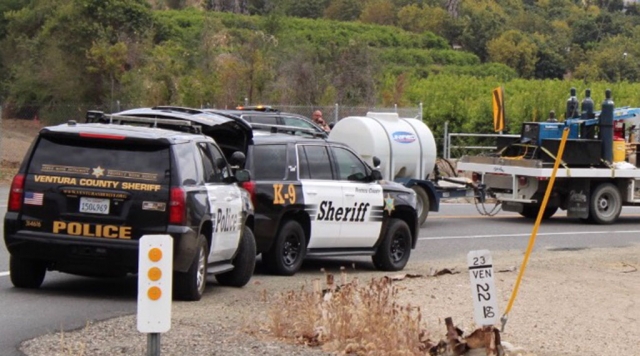 On April 22nd at 1:02pm, Ventura City Police Department was dispatched to a stolen vehicle located at Wells Road and Cirus Drive in Ventura. At approximately 1:45pm CHP was behind the stolen vehicle on Ventura Street and A Street in Fillmore. Four minutes later vehicle was eastbound at Ventura Street and Mountain View. At 1:59pm CHP were in pursuit, with subject located westbound at Guiberson Road, passing Auto & Sons Nursery. CHP had spike stripes deployed after canceling the pursuit due to pursued vehicle driving on wrong side of the road at 80 MPH. A Ventura County Sheriff’s Department unit spotted the vehicle southbound on Guiberson and a VCSO unit advised dispatched if their unit could take over pursuit, according to a VCSO watch commander. Stolen vehicle stopped in front of Elkins Ranch and subject fled on foot, northbound towards orchards, and a perimeter was conducted. A Ventura County Sheriff’s Department helicopter was on scene in the area attempting to locate the suspect. During the search a subject was detained by CHP. VCSO handed scene back to CHP. No information was made available on the subject arrest. Info courtesy Ventura County Sheriff’s Department West County traffic. Photos courtesy Angel Esquivel-AE News. Enlarge Photo |
|
By Anonymous — Wednesday, April 28th, 2021
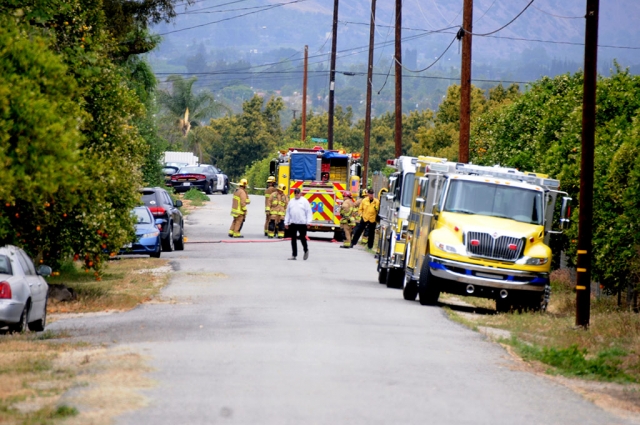 On April 24, 2021, at noon, a tan Buick sedan crashed into a 500 gallon propane tank in the 1000 block of Owen Street, Bardsdale. The collision ruptured the tank, and an evacuation of residents was ordered by the Fillmore Fire Department. CHP set up a temporary roadblock, according to sources. No injuries were reported, and the situation was safely resolved by agencies on the scene. Enlarge Photo |
|
By Anonymous — Wednesday, April 28th, 2021
Live in the Heritage Valley (Santa Paula, Fillmore, Piru) and need a ride to get your COVID vaccine? For a limited time, Valley Express is offering FREE rides on their Dial-A-Ride service to your vaccination appointment. Simply call 805-933-2267 to schedule your DAR trip after you secure your appointment. This service is not available for drive through vaccine appointments. Courtesy County of Ventura Facebook Page. |
|
By Anonymous — Wednesday, April 28th, 2021
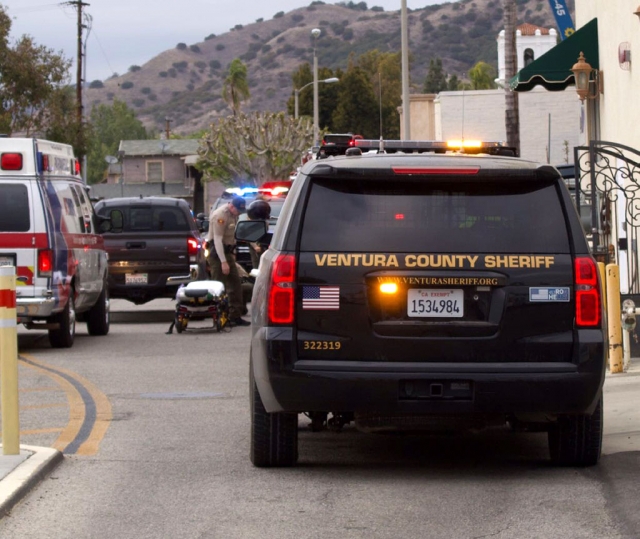 On Thursday, April 21, 2021 at 5:31pm, Fillmore Police Department, Fillmore Fire and AMR paramedics were dispatched to a vehicle versus pedestrian located in the alley east of Fillmore PD station. Arriving crews found a young patient on the ground with a bike down. Patient was treated by AMR and transported to a local hospital. Condition of the patient unknown. Fillmore Police Department units remained on scene to investigate the incident. Cause of the collision is under investigation. Photos courtesy Angel Esquivel-AE News. Enlarge Photo |
|
By Ventura County Sheriff Department — Wednesday, April 28th, 2021
The Fillmore Police Department will be hosting a program to educate newly licensed and future licensed drivers. Start Smart is a cooperative effort between the California Highway Patrol, Fillmore Police Department, teenage drivers, and their parents. In an attempt to remain proactive and not reactive, the Start Smart Program is designed to help young drivers and their parents/guardians understand the responsibilities associated with driving a motor vehicle. Start Smart will show how a poor choice behind the wheel can change the lives of everyone involved. Our goal is to raise awareness and reduce the number of teen-related injuries and deaths due to collisions. Interested parents are asked to call the Fillmore Police Department at 805-524-2233 or email RobertG.Thomas@Ventura.org for more information and to make a reservation; space is limited. There is no charge to attend the program. Due to Covid-19 health and safety guideline, this course will be offered online, via Microsoft Teams. Parents/child will have the ability to participate in the class from the safety of their homes and still be able to interact with the deputies presenting the course. This course will also be available in Spanish during the same allotted date/time as mentioned above. The Fillmore Police Department would like to thank the Fillmore Unified School District and Fillmore High School administration for their assistance so that students may use school-issued laptops to attend the class. The funding for this program is being provided by a grant issued from the California’s Office of Traffic Safety (OTS). Nature of Incident: Start Smart Driving Education Class |
|
By Anonymous — Wednesday, April 28th, 2021
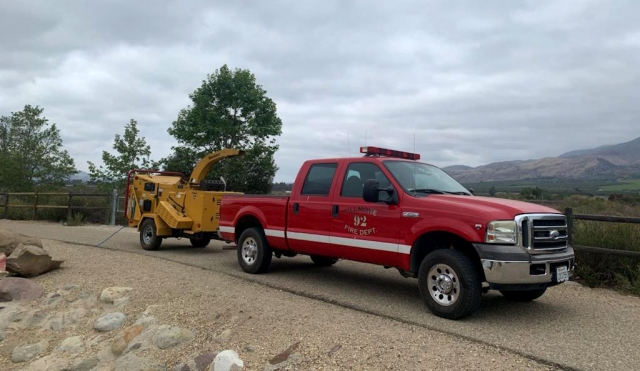 Fillmore City Fire crews were out working on local bike paths, clearing away overgrown brush last weekend. Pictured is one of the vehicles pulling a woodchipper. Enlarge Photo |
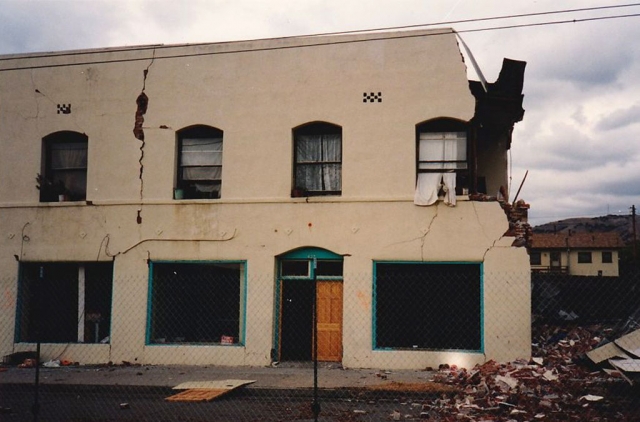 The Fillmore Hotel, which was one of many building that was damaged in the 1994 Northridge earthquake. Photos courtesy Fillmore Historical Museum. Enlarge Photo By Anonymous — Wednesday, April 28th, 2021
Courtesy Fillmore Historical Museum Do you remember the earthquake? For most in Fillmore that question would seem to refer to the 1994 Northridge Earthquake which devasted our downtown area, leaving vacant lots seen even today. But that was by no means the only quake to cause damage to our town. July 12, 1952, at 4:52 am, the Tehachapi Quake hit in a series of waves which lasted in diminishing strength for nearly 45 minutes. The damage here in Fillmore was noticeable but relatively light. There was firewall damage on roof at 340-340 1/2 Central Avenue (formerly Ragtyme Station). Ballard Furniture at 348 Central Ave. was also damaged. The train line through Fillmore suddenly became important once more after the Tehachapi quake. Train tunnels were caved in, the Ridge Route was blocked by a king-sized landslide. Trains were diverted through Fillmore for a time while the tracks were repaired. Fifty years ago, on February 9, 1971, a strong earthquake measuring 6.5 on the Richter Scale occurred in the Sylmar area of the San Fernando Valley. The shocks caused the upstairs wall of the Briggs Hardware Building (first known as Chili Franklin’s Pool Hall and Dance Hall when it was built in 1910) at 340 Central, to ripple and a large 70-foot chunk of bricks fell onto the roof of Martha’s, a dress shop just north at 344 Central (now Genesis Hair). An eye-witness later said when the brick mass hit Martha’s, the impact collapsed the roof and blew out the front windows. The store at 344 Central had to be rebuilt. The second story of 340 Central was so badly damaged it was removed. The second story had been a dance hall. The floor was left intact and is believed to still be there to this very day as part of a double ceiling. The Fillmore Hotel and the Filmore Citrus Association Packing House at A and Sespe had cracks in walls, but nothing major. Although the Fillmore Hotel survived the 1971 quake, In the 1994 quake it was destroyed. Luckily, and perhaps surprisingly, none of the school buildings suffered and damage from the 1971 quake. Several had already been taken out of service as class rooms under the Field Act which had been passed in 1933 after the Long Beach Earthquake, mandating that school buildings must be earthquake-resistant. Even these were not significantly damaged. As expected all the grocery stores in town had major clean up to do after the1971 quake. Aisles had to be cleaned as jars were thrown from shelves and damaged canned and boxed goods had to be disposed of. Enterprising high school students picked up some spare pocket money helping the store owners. Neither of these earthquakes were as devastating to our community and the 1994 Northridge Quake, but it’s good to remember that the 1994 quake was not an anomaly. We live in earthquake country and we are sure to have another one. The question is just when. |
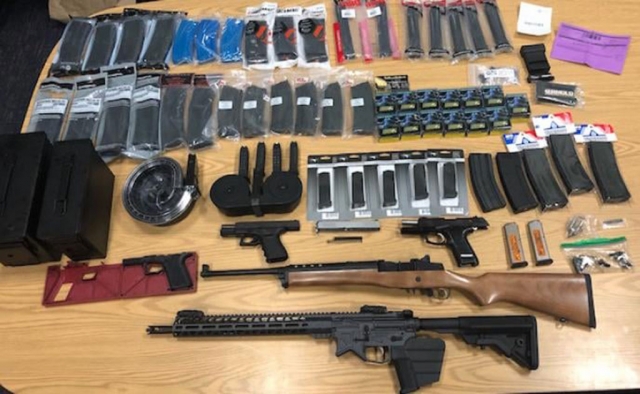 Deputies arrested Vargen for PC 32310 Possession of High Capacity Magazines and PC 30605(a) Possession of an Assault Rifle. Enlarge Photo By Ventura County Sheriff Department — Wednesday, April 21st, 2021
A check the wellbeing call results in the arrest of a 42-year-old Fillmore man for various weapons violations. On April 16, 2021, deputies received a call that Scott Vargen had been acting and talking in a bizarre manner. Deputies were told that Vargen had made statements about visualizing things and having messages sent to him. The reporting party was concerned about Vargen’s mental health wellbeing and notified law enforcement. Although the reporting party’s concern for Vargen’s wellbeing needed to be investigated, there was no immediate or imminent threat to the public. Deputies had the time to develop a plan, which included contacting the Ventura County Mental Health Crisis Intervention Team and requested their assistance. The Crisis Intervention Team (CIT) and deputies collaborated and conducted an investigation regarding these statements and behavior exhibited by Vargen. Deputies and CIT went to Vargen’s residence and spoke with him about his bizarre statements and behavior. During the interview, deputies learned that Vargen recently purchased several firearms. The deputies were able to inspect these firearms and determined one of the firearms was an illegal assault rifle. Vargen was in possession of several high capacity pistol and rifle magazines, in violation of California weapons regulations. Deputies arrested Vargen for PC 32310 Possession of High Capacity Magazines and PC 30605(a) Possession of an Assault Rifle. Vargen was booked at the Ventura County Main in lieu of $30,000.00 bail. The Fillmore Police Department would like to take this opportunity to express to the public if you see or hear something that is out of place or just not right, please say something. The adage of “See Something. Say Something.” relates to many different facets of our life. The Fillmore Police Department has access to many different resources and we can provide people with contacts to access those resources. Report Number: 21-50260 |
|
By Anonymous — Wednesday, April 21st, 2021
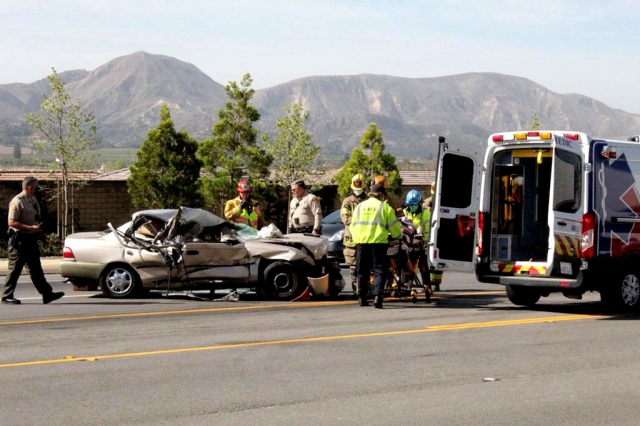 On Thursday, April 15, 2021 at 9:30am, the Ventura County Sheriff ’s Department, Fillmore Fire Department and AMR Paramedics were dispatched to a traffic collision located at Ventura Street (126 Highway) / Santa Clara Street, Fillmore. Arriving fire crews reported a semi truck and Toyota Corolla involved, with one person needing extrication and transported to VCMC, condition unknown. Toyota was reported in the center divider, with the semi on side lane, condition unknown. Police units shut down westbound traffic lanes until roadway was cleared. Cause of the crash is under investigation. Photo courtesy Angel Esquivel-AE News. Enlarge Photo |
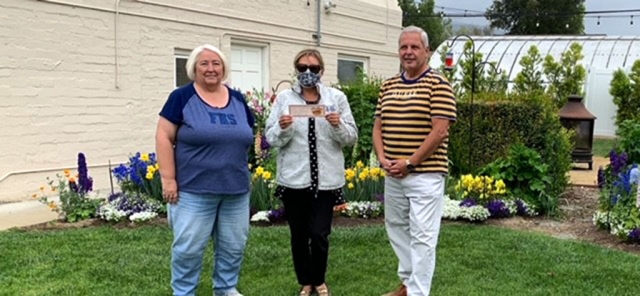 (l-r) Corinna Mozley, Fillmore High School Alumni Vice President and Ari Larson, Fillmore City Council Member, presenting FHS Alumni President Mark Ortega with a certificate from Otto & Sons Nursery for being selected March 2021 Yard of the Month. Photos Courtesy Matt Mozley. Enlarge Photo By Anonymous — Wednesday, April 21st, 2021
Fillmore Civic Pride presented FHS Alumni Park the March 2021 "Yard of the Month." They received a $40 gift certificate from sponsors Otto & Sons Nursery located at 1835 Guiberson Rd. in Fillmore. “Alumni Park is a gathering place for Fillmore High School Alumni," Mark Ortega, the president of the FHS Alumni, said. It is located at 559 Sespe Ave. right next door to the FHS Alumni office. According to Mark, currently featured in the garden are tall flowering stocks of delphiniums, fox gloves, Hollyhocks, and others. "All the daffodils were planted between Thanksgiving and Christmas of last year. They are all blooming at this time along with the other plants and flowers," he said. The entrance to the garden features a cute, white picket door. "We encourage the communities of Fillmore, Piru, Rancho Sespe, Bardsdale and especially our alumni to open our gates and come in and take photos. Alumni Park was created by our Fillmore High Alumni, for our Fillmore High Alumni. However, we hope all those who live in our beautiful surroundings can stop by enjoy the beautiful flowers and plants. Thank you again for awarding us Yard of the Month! We are honored," Mark said. For more information on Fillmore Civic Pride please call 805.794.7590 or email: petenari55@hotmail.com. |
|
By Anonymous — Wednesday, April 21st, 2021
 A strong police presence was in force Monday, April 19 at 9pm, in the 700 block of Del Valle in Fillmore. Reports were of a female being non-compliant with the officers, refusing to leave the residence. The police report classified it as a “Disturbance Subject”. The standoff ended at 12:11am, April 20th. No further information was made available. Enlarge Photo |
|
By Anonymous — Wednesday, April 21st, 2021
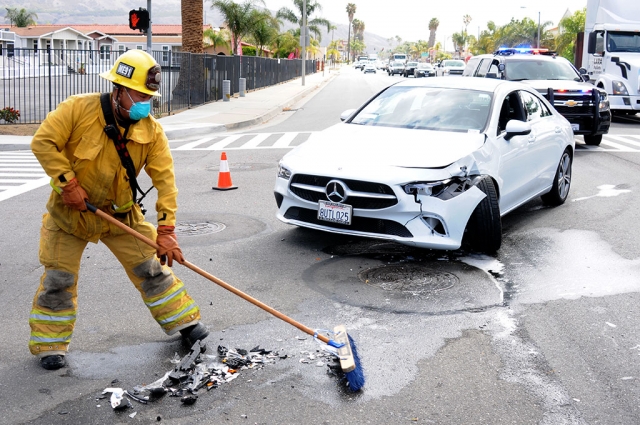 On Wednesday, April 14th at 8:50am, at the intersection of B & Ventura Street, a two-car collision occurred between a white Mercedes Benz and a white sedan. The sedan jumped the curb, causing major damage to the front end. The Mercedes sustained damages to the front driver’s side bumper and tire. Police directed traffic around the incident as they conducted their investigation and cleared the area. Cause of the crash is under investigation. Enlarge Photo |
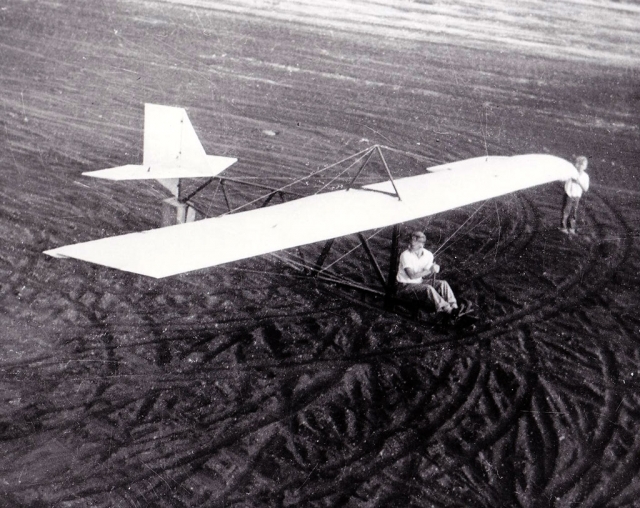 Don Shaw, in glider, and Ebbie Wileman at the wing. Photos courtesy Fillmore Historical Museum. Enlarge Photo By Anonymous — Wednesday, April 21st, 2021
Courtesy Fillmore History Museum After the First World War, a new phenomenon swept the United States – Barnstormers. Men, who often had learned to fly during the war, traveled the country doing aerobatics, showing the skill of the pilot and the sturdiness of the airplane. Frequently these barnstormers were employed by aircraft manufacturers. That was the case in August of 1919 when the first barnstormer came to Fillmore. Lieut. Arnold Popic was an “aerial demonstrator” for the Zenith Aviation Company. The August 8, 1919 Herald reported that Lt. Popic had arrived the prior Wednesday “floating gracefully over the city” in his open cockpit machine and landed in a field to the west of the Sespe bridge. Two tickets for flights had been sold, one to C. C. Bufkin and one to John Opsahl. Mr. Bufkin took the first flight. Unfortunately, the field had not been prepared properly and the plane struck a deep gully and “its snoot plowed in the opposite bank.” Neither Mr. Bufkin nor Lt. Popic were injured but the plane was damaged to the point it could not fly without repairs. The next week the following ad ran in the paper: Basolo field was a recently mown alfalfa field, located just south of the Bardsdale Bridge. Tickets were $10 for a 10-minute ride and it was reported that 53 tickets were sold for the three days, with the understanding Mr. Bufkin and Mr. Opsahl would get the first flights. For an extra charge, a customer like Homer Cheek, the manager of Rancho Sespe, could take the stunt flight which included flying upside down, along with dips, dives and spins. You could also pay extra to fly higher, up to 3500 feet. It was not just the men who took flight, several women including Edith Moore, age 21, and Hortense Wood, age 14. It is clear that this event and others like it inspired many folks in Fillmore to take up flight – either as pilots, or like Edith Jarrett, becoming world travelers. The news reports didn’t mention whether Betty Elkins, daughter of C. C. Elkins, Jr, and granddaughter of C. C. Elkins, took one of these flights in August of 1919. But according to a story in the May 21st, 2008 issue of the Gazette, Betty became interested in flying at the age of 9 when she won a ride in a Curtiss Jenny by selling magazine subscriptions. In 1929, she married a stunt pilot, Fred Lund, who was World Aerobatic Champion in 1930. Lund taught the former Betty Elkins to fly, and she soon set the woman’s record for doing sixty-seven barrel rolls in twenty-eight minutes. When Lund was killed while competing in a pylon race in Kentucky, Betty took over his appearance contracts and eventually began barnstorming on her own.By the end of the 1930s she was one of the leading stunt pilots in the country. During World War II she served as a WAF transporting airplanes from the West Coast production plants to the East Coast for transport to Europe. Some young people were not content with flying the machines, some wanted to build them too. Two high school students, Don Shaw and Edward “Ebbie” Wileman, built a glider about 1931. No one expected it to fly but fly it did. Unfortunately, it was destroyed in a windstorm. Fillmore’s first airstrip was created in 1928, just east of town and south of the highway, near the current fish hatchery. The area had been swept clean of vegetation by the St. Francis Dam flood. The oil from the Ventura Refinery (later Texaco) was poured on the future runway, covered in sand, disked in and the steps repeated. After compacting by driving heavy trucks over it, the airfield was ready. Many Fillmoreians learned to fly on this strip. This strip was eventually abandoned with the Depression and World War II. Before it went out of service, L. E. Hammond announced the opening of a complete aircraft and engine service. To help advertise his new venture, he flew his own plane under the Bardsdale Bridge, with several inches to spare above and below. Despite not having a formal airfield, airplanes did insist on landing at Fillmore. The story is told of one dark, rainy evening residents hearing the sound of a large plane circling the town. No one is sure how the word got out but within minutes a line of automobiles hurried out of town to a likely flat spot and divided into two rows of bright headlights, one on each side of the impromptu runway, to guide the pilot in. Through the rain a Lockheed Electra made a three-point landing with five terrified passengers. Apparently, the plane had left Bakersfield for Burbank and had gotten lost. After World War II there was renewed interest in having an airport and a new airfield opened near where that first barnstorming plane landed in 1919 and once again became known as Basolo Field, but never received support from the town fathers so lasted only a few years. |
|
By Anonymous — Wednesday, April 14th, 2021
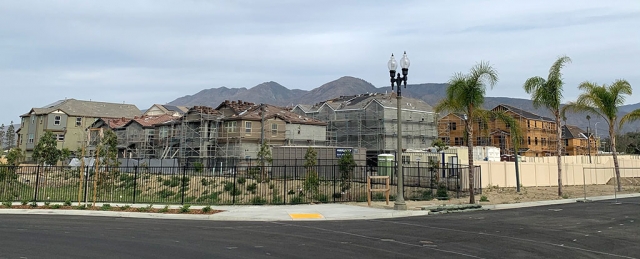 KB Homes Citrus Grove development behind Vons shopping center on River Street as shown from the back of the property looking north from Edgewood and Central Avenue. These are just some of the 104 units being built on the property to house 375 residents. Enlarge Photo |
|
By Anonymous — Wednesday, April 14th, 2021
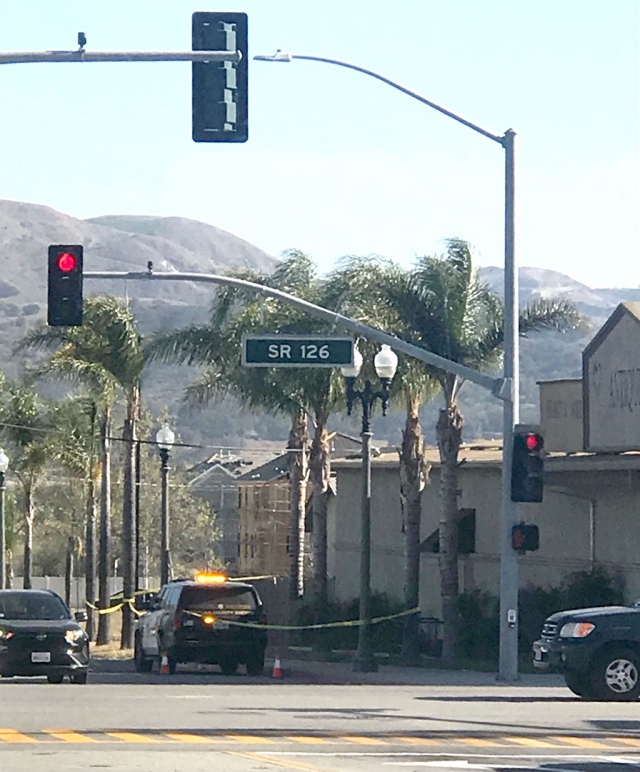 On Friday, April 9th, at approximately 4pm at the corner of Central Avenue and Ventura Street, a fight broke out. Police, CSI and Sheriff ’s detectives responded to the scene to secure the area to conduct their investigation. No further information was available. Photo courtesy Angel Esquivel—AE News. Enlarge Photo |
|
By Anonymous — Wednesday, April 14th, 2021
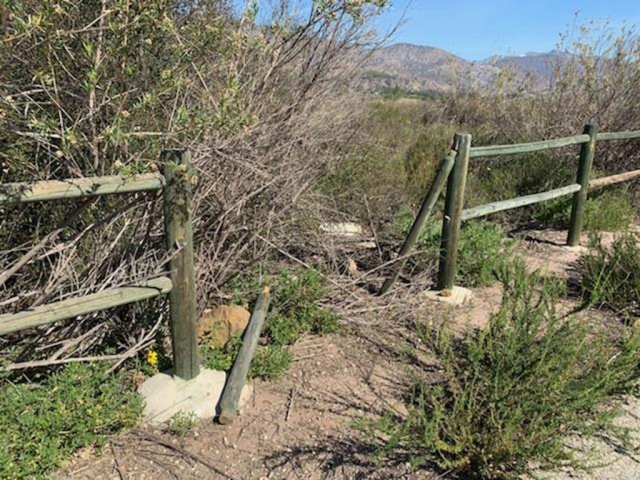 Fillmore’s scenic bike paths are in need of repair. Vandals have damaged the wood posts along the path to the north of the City’s water reclamation plant and running along the east side of the Sespe River heading into north Fillmore. Graffiti, trash and canine waste are also a problem along the paths. Enlarge Photo |

